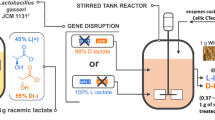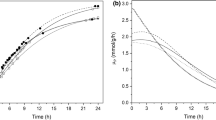Abstract
Lactococcus lactis subsp. lactis biovar. diacetylactis was selected to study the physiological influences of immobilization and growth to high cell densities. Cells were cultivated on glucose or lactose medium in the presence and absence of citrate. With excess glucose the cells produced mainly lactate as the fermentation product (homofermentative) providing that not all of the substrate was consumed. The population so cultivated was exposed to extreme gradients of pH and lactate concentrations. When the glucose concentration was reduced the population showed a mixed product profile with half of the glucose being fermented to lactate, the remainder to formate, acetate, ethanol and 2,3-butanediol. Inclusion of citrate in the medium shifted the population to homofermentation, with respect to the amount of glucose or lactose consumed. The citrate was metabolized via the pyruvate-formate lyase and α-acetolactate synthase routes. The pH of the medium was shown to strongly influence the product profile from citrate, presumably by affecting the activity of the key enzymes of pyruvate metabolism. The lactococci immobilized at high cell densities show product profiles typical of carbohydrate limitation at low dilution rates.
Similar content being viewed by others
References
Abbe K, Takahashi S, Yamada T (1982) Involvement of oxygen-sensitive pyruvate-formate lyase in mixed-acid fermentations by Streptococcus mutans under strictly anaerobic conditions. J Bacteriol 152:175–182
Broome MC, Thomas MP, Hillier AJ, Jago GR (1980) Pyruvate dehydrogenase activity in Group N streptococci. Aust J Biol Sci 33:15–25
Bunch AW (1988) The uses and future potential of microbial hollow-fibre bioreactors. J Microbiol Methods 8:103–119
Champagne CP, Gaudy C, Poncelet D, Neufeld RJ (1992) Lactococcus lactis release from calcium alginate beads. Appl Environ Microbiol 58:1429–1434
Crow VL (1990) Properties of 2,3-butanediol dehydrogenase from Lactococcus lactis subsp. lactis in relation to citrate fermentation. Appl Environ Microbiol 56:1656–1665
Drinan DF, Tobin S, Cogan TM (1976) Citric acid metabolism in hetero- and homofermentative lactic acid bacteria. Appl Microbiol 31:481–486
El-Gendy SM, Abdel-Galil H, Shahin Y, Hegazi FZ (1983) Acetoin and diacetyl production by homo- and heterofermentative lactic acid bacteria. J Food Prot 46:420–425
Guoqiang D, Kaul R, Mattiasson B (1991) Evaluation of alginate-immobilized Lactobacillus casei for lactate production. Appl Microbiol Biotechnol 36:309–314
Harvey RJ, Collins EB (1963) Roles of citrate and acetoin in the metabolism of Streptococcus diacetylactis. J Bacteriol 86:1301–1307
Hugenholtz J, Starrenburg M (1992) Diacetyl production by different strains of Lactococcus lactis subsp. lactis biovar. diacetylactis and Leuconostoc sp. Appl Microbiol Biotechnol in press
Inloes DS, Smith WJ, Taylor DP, Cohen SN, Michaels AS, Robertson CR (1983) Hollow-fiber membrane bioreactors using immobilized E. coli for protein synthesis. Biotechnol Bioeng 25:2653–2681
Inloes DS, Michaels AS, Robertson CR, Martin A (1985) Ethanol production by nitrogen-deficient yeast cells immobilised in a hollow-fibre membrane bioreactor. Appl Microbiol Biotechnol 23:85–91
Kandler O (1983) Carbohydrate metabolism in lactic acid bacteria. Antonie van Leeuwenhoek 49:209–224
Kaneko T, Suzuki H, Takehashi T (1987) The effect of metal ions on the production of diacetyl by Streptococcus lactis subsp. diacetylactis 3022. Agric Biol Chem 51:2315–2320
Kaneko T, Watanabe Y, Suzuki H (1990) Enhancement of diacetyl production by a diacetyl-resistant mutant of citrate positive Lactococcus lactis subsp. lactis 3022 and by aerobic conditions of growth. J Dairy Sci 73:291–298
Lindmark DG, Paoblea P, Wood HG (1969) The pyruvate-formate lyase system of Streptococcus faecalis. I. Purification and properties of the formate-pyruvate exchange. J Biol Chem 244:3605–3612
Linton EA, Higton G, Knowles CJ, Bunch AW (1989) Monitoring microbial growth in a hollow-fiber reactor using an electronic pressure sensor. Enzyme Microb Technol 11:283–288
Morin N, Bernier-Cardou M, Champagne CP (1992) Production of Lactococcus lactis biomass by immobilized cell technology. J Ind Microbiol 9:131–135
Ochi H, Takahashi M, Kaneko T, Suzuki H, Tanaka H (1991) Diacetyl production by co-immobilized citrate-positive Lactococcus lactis subsp. lactis 3022 and homogenized bovine liver in alginate fibres with double gel layers. Biotechnol Lett 13:505–510
Smith MR, Hugenholtz J, Mikóczi P, Ree E de, Bunch AW, Bont JAM de (1992) The stability of the lactose and citrate plasmids in Lactococcus lactis subsp. lactis biovar. diacetylactis. FEMS Microbiol Lett 96:7–12
Snoep JL, Teixeira de Mattos MJ, Starrenburg MJC, Hugenholtz J (1992) Isolation, characterization, and physiological role of the pyruvate dehydrogenase complex and α-acetolactate synthase of Lactococcus subsp. lactis bv. diacetylactis. J Bacteriol 174:4838–4841
Starrenburg MJC, Hugenholtz J (1991) Citrate fermentation by Lactococcus and Leuconostoc spp. Appl Environ Microbiol 57:3535–3540
Takahashi M, Ochi H, Kaneko T, Suzuki H, Tanaka H (1990) Diacetyl production by immobilized citrate-positive Lactococcus lactis subsp. lactis 3022 in the fibrous Ca-alginate gel. Biotechnol Lett 12:569–574
Thomas TD, Ellwood DC, Longyear VMC (1979) Changes from homo- to heterolactic fermentation by Streptococcus lactis resulting from glucose limitation in anaerobic chemostat cultures. J Bacteriol 138:109–117
Thornhill PJ, Cogan TM (1984) Use of gas-liquid chromatography to determine the end products of growth of lactic acid bacteria. Appl Environ Microbiol 47:1250–1254
Tramper J (1989) Conversions by immobilized cells versus traditional fermentations. In: Bont JAM de, Visser J, Mattiasson B, Tramper J (eds) Physiology of immobilized cells. Elsevier, Amsterdam, pp 115–126
Verhue WM, Tjan FSB (1991) Study of the citrate metabolism of Lactococcus lactis subsp. lactis biovar. diacetylactis by means of 13C nuclear magnetic resonance. Appl Environ Microbiol 57:3371–3377
VickRoy TB, Blanch HW, Wilke CR (1983) Lactic acid production by Lactobacillus delbrueckii in a hollow-fiber fermenter. Biotechnol Lett 4:483–488
Author information
Authors and Affiliations
Additional information
Correspondence to: M. R. Smith
Rights and permissions
About this article
Cite this article
Smith, M.R., van der Schaaf, A., de Ree, E.M. et al. The physiology of Lactococcus lactis subsp. lactis biovar. diacetylactis immobilized in hollow-fibre bioreactors: glucose, lactose and citrate metabolism at high cell densities. Appl Microbiol Biotechnol 39, 94–98 (1993). https://doi.org/10.1007/BF00166855
Received:
Accepted:
Issue Date:
DOI: https://doi.org/10.1007/BF00166855




